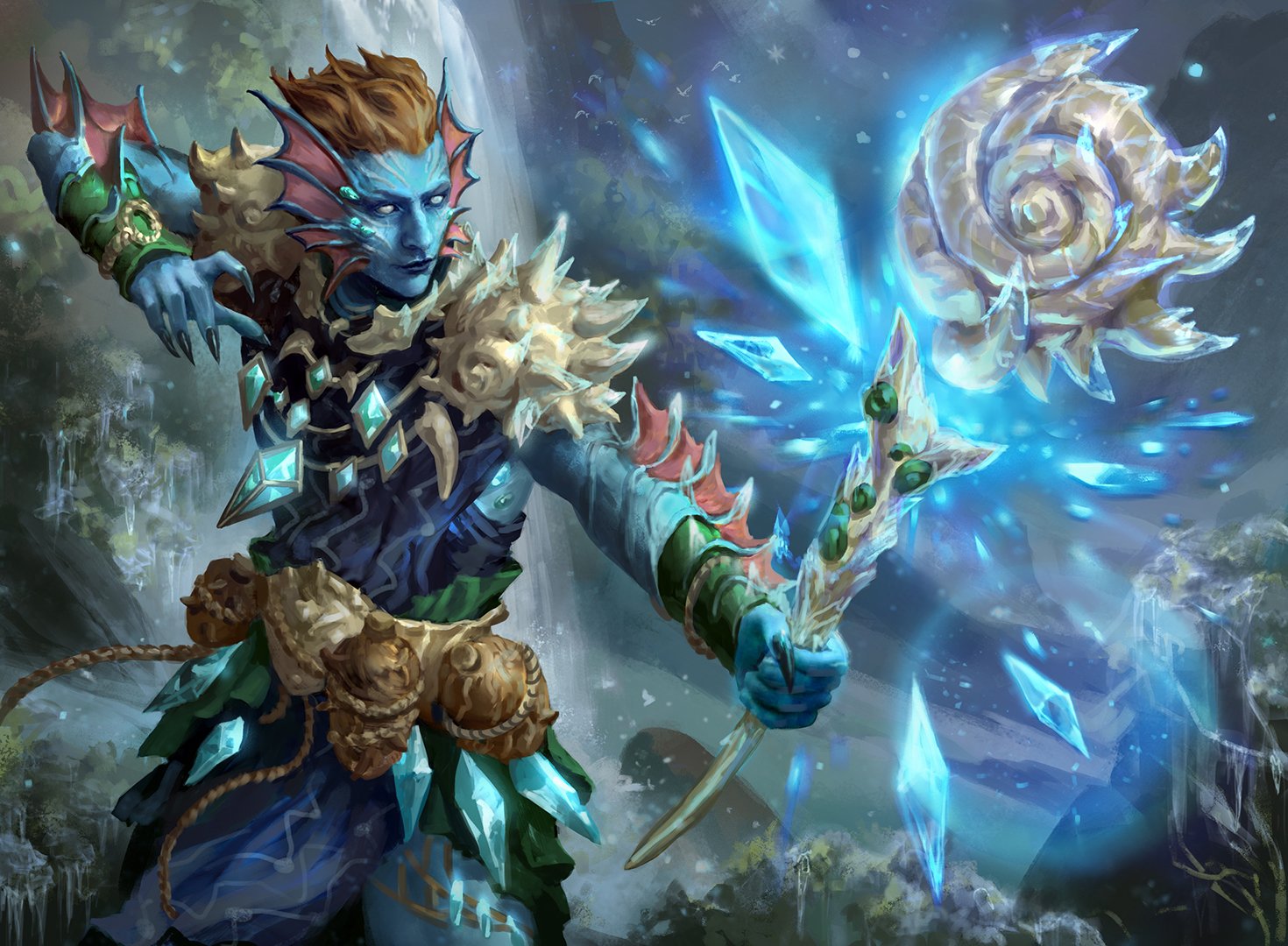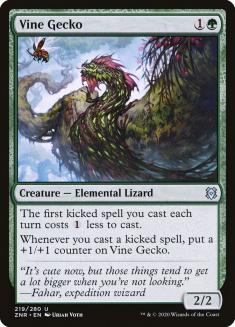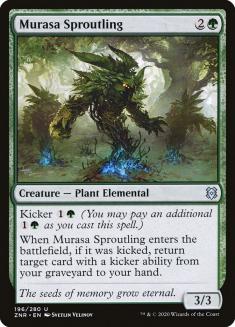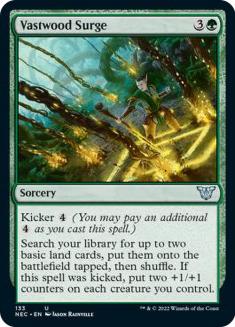The first thing I recognized about Zendikar Rising is that this format appears much more about macro-synergy than micro-synergy. Landfall encompasses multiple green decks. So does kicker. All nongreen decks have some form of tribal support, tethered by the party mechanics. There’s quite a lot of overlap between the set mechanics, facilitating color pairs that share macro-archetypes.
This will make draft a bit harder to grasp. Izzet isn’t just a spells-matters deck that can easily wheel cards other drafters aren’t interested in. The Izzet color combination also cares about Wizards. Any deck that touches the party mechanic could potentially cannibalize creatures from Izzet. It will be more difficult to read signals due to this, but it also becomes easier to pivot between strategies. For example, If Izzet was spells-matters and Azorius was flyers, pivoting from Izzet to Azorius likely requires throwing away a significant number of early picks. However, since both archetypes share the party macro-archetype, pivoting from one to the other is less costly.
This phenomenon is described in depth in the last section of one of my more recent articles: Draft Navigation: From Picks To Paths. My goal today is to approach the question of “learning paths before the draft.” By looking at the set and gold commons, I hope to determine which color combination will be easy to pivot from a different given color combination. First, let’s take a look at every archetype defined by their respective gold card.
- Azorius Party (control): Spoils of Adventure
- Orzhov Clerics (lifegain): Cleric of Life’s Bond
- Boros Warriors (equipment): Kargan Warleader
- Selesnya Landfall (go-wide): Murasa Rootgrazer
- Dimir Rogues (mill): Soaring Thought-Thief
- Izzet Wizards (spells-matters): Umara Mystic
- Simic Kicker (kicker-matters): Lullmage’s Familiar
- Rakdos Party (aggro): Ravager’s Mace
- Golgari Kicker (+1/+1 counters): Moss-Pit Skeleton
- Gruul Landfall (hit-hard): Brushfire Elemental
My hypothesis, after considering the intersection of all these paths, is that both Rakdos and Azorius will be hubs.
When considering all the potential paths a draft has to offer, Azorius and Rakdos have a considerably larger role than other archetypes. Notice that every tribal archetype shares a color with both Azorius and Rakdos. At this point, it’s unclear how Azorius and Rakdos intersect with the green archetypes. The manner in which they intersect will likely be a function of speed. If Rakdos is aggressive, it will overlap more with Gruul than Golgari. However, it’s fairly clear that green is a bit separated from the tribal archetypes, as demonstrated in Mark Rosewater’s article on September 1st.
By creature type:
Cleric
- Primary – White
- Secondary – Black
- Teritary – Blue
- Absent – Red
Rogue
- Primary – Black
- Secondary – Blue
- Tertiary – Red
- Absent – White
Warrior
- Primary – Red
- Secondary – White
- Tertiary – Black
- Absent – Blue
Wizard
- Primary – Blue
- Secondary – Red
- Tertiary – White
- Absent – Black
And by color:
White
- Cleric (primary)
- Warrior (secondary)
- Wizard (tertiary)
- Rogue (none)
Blue
- Wizard (primary)
- Rogue (secondary)
- Cleric (tertiary)
- Warrior (none)
Black
- Rogue (primary)
- Cleric (secondary)
- Warrior (tertiary)
- Wizard (none)
Red
- Warrior (primary)
- Wizard (secondary)
- Rogue (tertiary)
- Cleric (none)
Green
- Cleric (tertiary)
- Rogue (tertiary)
- Warrior (tertiary)
- Wizard (tertiary)
The preference pivoting towards Azorius or Rakdos from another tribal archetype will be dependent on synergistic maintenance and speed. Consider the following example:
You’re drafting an Orzhov Clerics deck, but as Pack 1 develops, you become certain that Orzhov is not open. You can likely pivot towards Azorius, Boros, Rakdos, or Dimir. First, observe that Azorius is a better option than Rakdos if maintaining Cleric synergy is important because red has no Clerics. However, Rakdos could be a better option than Azorius if a full party matters more, because starting with Orzhov Clerics means that the Cleric aspect of the party is already accounted for. Speed matters as well. If the Orzhov deck is aggressive, Rakdos will fit better, and if it is not, Azorius may fit better. Lastly, If one of the larger hubs doesn’t present itself, an aggressively leaning Orzhov deck can pivot to Boros, and a slower variant can pivot to Dimir.
I won’t dig into this for every single archetype, but they all have the same structure. Different synergies point to either Rakdos or Azorius as a better pivot (although both will always be options). And different paces point to either of the other tribal-oriented archetypes. The important observation is that any given party-start has two optimal pivots, and two suboptimal pivots corresponding to synergy and speed. Understanding this makes it much easier to capitalize on the best lane for any given seat. For example, if I’m pivoting from aggressive Orzhov to Dimir, Dimir must be extremely open. Whereas if I’m pivoting from aggressive Orzhov to Boros, I’ll be giving up less playables, and hence it doesn’t require such a 180.
Green, on the other hand, has more straightforward path intersections. Given that the only way green contributes to tribal synergy is with uncommons like Veteran Adventurer, green archetypes will most commonly pivot towards other green archetypes. There will be exceptions where it is correct to pivot from Selesnya Landfall to Boros Warriors, but that will be a less common path due to lack of synergistic overlap.
I actually find this a bit concerning. Gruul and Selesnya are both landfall strategies, and hence overlap quite a bit. Simic and Golgari are both late-game kicker strategies, and hence they also overlap. But maneuvering a draft to pivot between Gruul and Simic might prove difficult. And if it is difficult to move between green archetypes, that puts green at a disadvantage in this format. It becomes easier to draft an open archetype by starting the draft with a nongreen card thanks to how Azorius and Rakdos function as hubs. The intersection between all party archetypes create a fluid connection such that many cards for each of those archetypes ports over well to other archetypes. And while I hope that green archetypes have a similarly fluid relationship, my initial look at the set raises a concern about that.





